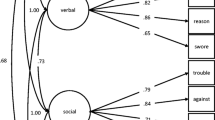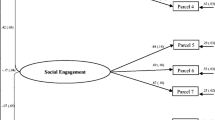Abstract
A shortened version of the Pupil Evaluation Inventory (PEI) was evaluated. The shortened version consists of nine items and was administered to 381 third-, fourth-, and fifth-graders in Chicago area Catholic schools. A factor analysis revealed the same factor structure as the original measure. Correlations with other sociometric ratings and the Achenbach Teacher Report Form were moderate to strong. A series of ANOVAs was used to compare the factors of the PEI to the five social status groups calculated from a peer nominations measure, and significant differences were found. Rejected children received higher scores on Aggression and Withdrawal than any other group, and popular children scored significantly higher on Likability.
Similar content being viewed by others
References
Achenbach, T. M., & Edelbrock, C. S. (1983).Manual for the Child Behavior Checklist and the Revised Child Behavior Profile. Burlington, VT: University Associates in Psychiatry.
Coie, J. D., & Dodge, K. A. (1983). Continuities and changes in children's social status: A cross-age perspective.Merrill Palmer Quarterly, 29(3), 261–282.
Coie, J. D., Dodge, K. A., & Coppotelli, H. (1982). Dimensions and types of social status: A cross-age perspective.Developmental Psychology, 9, 326–337.
Gresham, F. M. (1981). Validity of social skills measures for assessing social competence in low-status children: A multivariate investigation.Developmental Psychology, 17(4), 390–398.
Hollingshead, A. B. (1975).Four factor index of social status. Unpublished manuscript, Yale University, 1965 Yale Station, New Haven, CT 06520.
Jason, L. A., Betts, D., Johnson, J., Smith, S., Krueckeberg, S., & Craddock, M. (1989). An evaluation of an orientation plus tutoring school-based prevention program.Professional School Psychology, 5, 273–284.
Kane, J. S., & Lawler, E. E., III. (1978). Methods of peer assessment.Psychological Bulletin, 85(3), 555–586.
Kupersmidt, J. B. (1983). Predicting delinquency and academic problems from childhood peer status. In J. D. Coie (Chair),Strategies for identifying children at social risk: Longitudinal correlates and consequences. Symposium conducted at the biennial meeting of the Society for Research in Child Development, Detroit.
Lesser, G. S. (1959). The relationships between various forms of aggression and popularity among lower class children.Journal of Educational Psychology, 50, 20–25.
Masters, J. C., & Furman, W. (1981). Popularity, individual friendship selection, and specific peer interaction among children.Developmental Psychology, 17(3), 344–350.
Oden, S., & Asher, S. R. (1977). Coaching children in social skills for friendship making.Child Development, 48, 495–506.
Parker, J. G., & Asher, S. R. (1987). Peer relations and later personal adjustment: Are low-accepted children at risk?Psychological Bulletin, 102(3), 357–389.
Pekarik, E. G., Prinz, J. P., Liebert, D. E., Weintraub, S., & Neale, J. M. (1976). The Pupil Evaluation Inventory: A sociometric technique for assessing children's social behavior.Journal of Abnormal Child Psychology, 4(1), 83–97.
Roff, M., & Sells, S. (1968). Juvenile delinquency in relation to peer acceptance, rejection, and socioeconomic status.Psychology in the Schools, 5, 3–18.
Rolf, J. E. (1972). The academic and social competence of school children vulnerable to schizophrenia and other behavior pathologies.Journal of Abnormal Psychology, 80, 225–243.
Author information
Authors and Affiliations
Additional information
Special thanks to Loisa Bennetto for reading the many drafts of this paper and to Jay Johnson, who helped with some of the initial analyses. Thanks also to the generous financial suppport from the National Institute of Mental Health (grant 40851).
Rights and permissions
About this article
Cite this article
Lardon, C., Jason, L.A. Validating a brief pupil evaluation inventory. J Abnorm Child Psychol 20, 367–376 (1992). https://doi.org/10.1007/BF00918982
Revised:
Issue Date:
DOI: https://doi.org/10.1007/BF00918982




